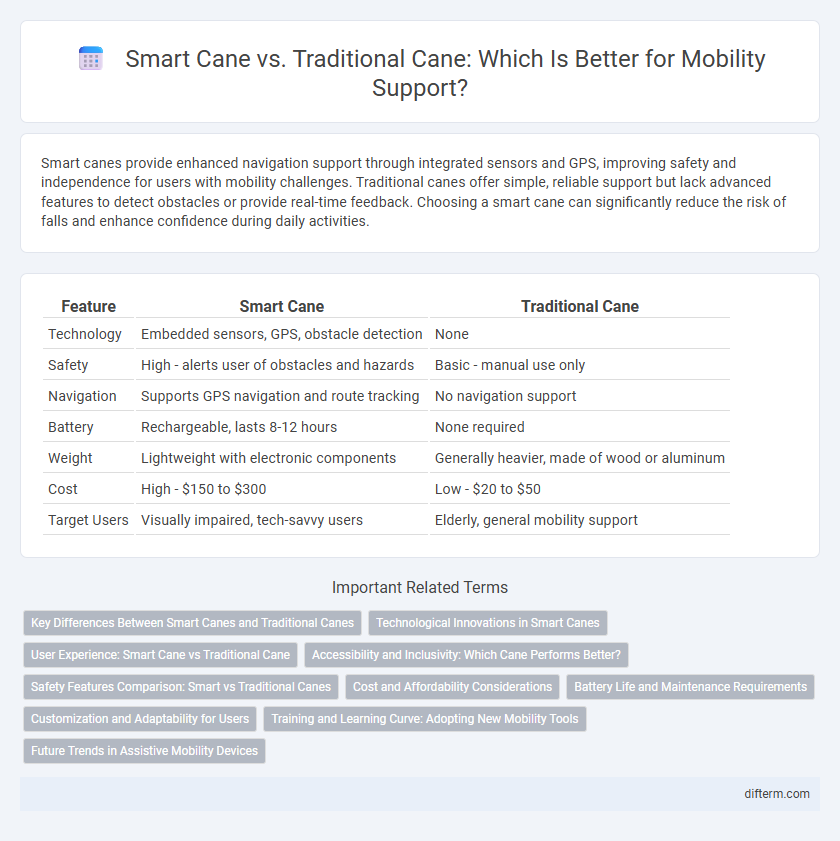Smart canes provide enhanced navigation support through integrated sensors and GPS, improving safety and independence for users with mobility challenges. Traditional canes offer simple, reliable support but lack advanced features to detect obstacles or provide real-time feedback. Choosing a smart cane can significantly reduce the risk of falls and enhance confidence during daily activities.
Table of Comparison
| Feature | Smart Cane | Traditional Cane |
|---|---|---|
| Technology | Embedded sensors, GPS, obstacle detection | None |
| Safety | High - alerts user of obstacles and hazards | Basic - manual use only |
| Navigation | Supports GPS navigation and route tracking | No navigation support |
| Battery | Rechargeable, lasts 8-12 hours | None required |
| Weight | Lightweight with electronic components | Generally heavier, made of wood or aluminum |
| Cost | High - $150 to $300 | Low - $20 to $50 |
| Target Users | Visually impaired, tech-savvy users | Elderly, general mobility support |
Key Differences Between Smart Canes and Traditional Canes
Smart canes integrate advanced technologies such as GPS navigation, obstacle detection sensors, and smartphone connectivity, enhancing mobility and safety for visually impaired users. Traditional canes rely solely on physical feedback for navigation and do not provide electronic assistance or real-time data. The key differences lie in smart canes' ability to offer interactive guidance and environmental awareness, which traditional canes lack.
Technological Innovations in Smart Canes
Smart canes integrate advanced sensors, GPS tracking, and obstacle detection technology to enhance mobility and safety for users, unlike traditional canes which offer only basic physical support. Features such as ultrasonic sensors and real-time navigation assistance provide users with immediate feedback on their environment, reducing accidents and improving independence. These technological innovations have transformed mobility aids into intelligent devices that adapt to dynamic urban settings and various terrains.
User Experience: Smart Cane vs Traditional Cane
Smart canes enhance user experience by integrating sensors and GPS technology, providing real-time obstacle detection and navigation assistance, which significantly reduces the risk of accidents for visually impaired users. Traditional canes rely solely on tactile feedback, limiting users to physical detection of immediate obstacles without advanced warning. The smart cane's connectivity to mobile apps and voice alerts offers personalized support, improving independence and confidence during daily mobility.
Accessibility and Inclusivity: Which Cane Performs Better?
Smart canes enhance accessibility by integrating GPS navigation, obstacle detection, and voice assistance, making them highly inclusive for visually impaired users in diverse environments. Traditional canes provide basic support and obstacle detection through tactile feedback but lack advanced technology, limiting their effectiveness in complex or unfamiliar settings. The smart cane outperforms the traditional cane in promoting independence and safety, thereby offering superior accessibility and inclusivity for users.
Safety Features Comparison: Smart vs Traditional Canes
Smart canes enhance safety with integrated sensors that detect obstacles, provide real-time feedback, and connect with mobile apps for location tracking, significantly reducing accident risks compared to traditional canes. Traditional canes rely solely on physical support and tactile feedback, offering limited hazard detection and no electronic assistance. The advanced technology in smart canes supports users with visual impairments by improving spatial awareness and alerting them to immediate dangers, thereby increasing overall mobility safety.
Cost and Affordability Considerations
Smart canes typically have higher upfront costs ranging from $100 to $500 due to integrated technology such as GPS and obstacle sensors, while traditional canes average between $20 and $50. Maintenance and repair expenses for smart canes can also increase overall affordability concerns, requiring battery replacements or software updates. For budget-conscious users, traditional canes offer a cost-effective and reliable mobility aid without ongoing expenses.
Battery Life and Maintenance Requirements
Smart canes typically offer rechargeable batteries with usage lasting between 8 to 12 hours per charge, requiring periodic charging to maintain optimal performance. Traditional canes demand minimal maintenance, mainly focusing on cleaning and checking for physical wear without any electronic components. The maintenance for smart canes involves both electronic upkeep and software updates, making traditional canes more straightforward but less feature-rich in comparison.
Customization and Adaptability for Users
Smart canes offer advanced customization options such as adjustable vibrations, GPS integration, and obstacle detection tailored to individual mobility needs, enhancing user safety and independence. Traditional canes provide basic support but lack adaptability features, limiting their effectiveness for users with varying terrain or complex environments. Enhanced adaptability in smart canes promotes personalized mobility solutions, improving overall user experience and confidence.
Training and Learning Curve: Adopting New Mobility Tools
Smart canes feature integrated technology such as obstacle detection sensors and GPS navigation, requiring users to learn digital interfaces and sensor feedback for effective use. Traditional canes offer simpler, intuitive use with minimal training, relying primarily on physical support and tactile feedback. The learning curve for smart canes is steeper but can enhance mobility independence once mastered, while traditional canes provide immediate usability with limited adaptation needs.
Future Trends in Assistive Mobility Devices
Smart canes integrate advanced sensors and GPS technology, providing real-time navigation assistance and obstacle detection for enhanced user safety compared to traditional canes. Future trends emphasize AI-powered analytics and connectivity with smart city infrastructure, enabling personalized mobility support and remote monitoring. These innovations aim to improve independence and quality of life for users with visual impairments or mobility challenges.
Smart cane vs Traditional cane Infographic

 difterm.com
difterm.com